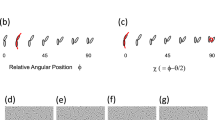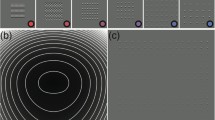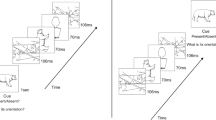Abstract
This study investigated how visual systems recover depth-order from orientation-defined junctions. Stimuli were superimposed stripes defined by Gabor micro-patterns (Gabors). In one stripe (random stripe), Gabor orientation was randomly selected from a given range, while in the other (constant stripe) it was selected so as to be different from the mean orientation of the random stripe by 90°. Observers reported which of the two stripes, the right- or left-tilted one, they perceived as “nearer” than the other. Observers frequently reported that the random stripe was nearer than the constant stripe. The results appeared to stem from detection of discontinuity of texture edges of the constant stripe due to masking by the random stripe at junctions. This idea was confirmed in the following experiments where discontinuity of the texture edges at junctions was introduced by changing the Gabor luminance contrast in one stripe but keeping it intact in the other. The results indicated that processing of texture edges at junctions can contribute to the perception of depth-order.









Similar content being viewed by others
Notes
Some observers participating in both Experiments 1 and 2 debriefed that the task in the latter experiment was more difficult than that in the former one. We suppose that the high task difficulty in Experiment 2 might cause response bias towards ‘no depth, resulting in the reduced proportion of other two responses even in 100% density condition which was just the same as the 180° in Experiment 1.
In the experiments 1 and 2, 95% confidence interval showed that in most of experimental conditions, proportion of ‘no depth perception’ was not deviated from chance level. This outcome might be because observers tried to make each response in a similar frequency. Hence, it was unlikely that the inducing of a non-depth order choice in the procedure allows collecting more accurate data than a forced choice task. Rather, it was highly likely that the response category ‘no depth was perceived’ worked as a kind of noise in the judgment for our stimuli. On the other hand, the response proportion for other categories changed consistently with experimental manipulations such as distribution ranges (exp. 1) or the density of Gabors at junctions (exp. 2). From this point of view, we employed a two alternative forced-choice task in the experiments 3 and 4, instead of the non-forced choice task.
References
Adelson EH (1993). Perceptual organization and the judgment of brightness. Science 262:2042–2044
Bressan P, Ganis G, Vallortigara G (1993). The role of depth stratification in the solution of the aperture problem. Perception 22:215–228
Chubb C, Sperling G (1988) Drift-balanced random stimuli: a general basis for studying non-Fourier motion perception. J Opt Soc Am A 5:1986–2007
Dresp B, Durand S, Grossberg S (2002). Depth perception from pairs of overlapping cues in pictorial displays. Spatial Vision 15:255–276
Grove PM, Ono H, Kaneko H (2003) T-junctions and perceived slant of partially occluded surfaces. Perception 32:1451–1464
Guibal CR, Dresp B (2004) Interaction of color and geometric cues in depth perception: when does “red” mean “near”? Psychological Research (on line first) (DOI: 10.1007/s00426-003-0167-0)
Gurnsey R, Humphrey GK, Kapitan P (1992) Parallel discrimination of subjective contours defined by offset gratings. Percept Psychophys 52:263–276
Haekkinen J, Nyman G (1997) Occlusion constraints and stereoscopic slant. Perception 26:29–38
Hubel DH, Wiesel TN (1965a) Receptive fields and functional architecture of monkey striate cortex. J Physiol 195:215–243
Hubel DH, Wiesel TN (1965b) Receptive fields, and functional architecture in two nonstriate visual areas (18 and 19) of the cat. J Neurophysiol 28:229–289
Kawabe T, Miura K (2004a) Configuration effects on texture transparency. Spatial Vision 17:187–200
Kawabe T, Miura K (2004b) Surface segregation driven by orientation-defined junctions. Exp Brain Res 158:391–395
Kawabe T, Miura K (2005) Mechanism responsible for texture transparency tunes to second-order structures. Vision Res 45:373–379
Landy MS, Bergen JR (1991) Texture segregation and orientation gradient. Vision Res 31:679–691
Malik J, Perona P (1990) Preattentive texture discrimination with early visual mechanisms. J Opt Soc Am A 7:923–932
Metelli F (1974) The perception of transparency. Sci Am 230:90–98
Metelli F, Da Pos O, Cavedon A (1985) Balanced and unbalanced, complete and partial transparency. Percept Psychophys 38:354–366
Mitsudo H (2003) Information regarding structure and lightness based on phenomenal transparency influences the efficiency of visual search. Perception 32:53–66
Motoyoshi I, Nishida S (2001) Visual response saturation to orientation-based texture segregation. J Opt Soc Am A 18:2209–2219
O’Shea RP, Blackburn SG, Ono H (1994) Contrast as a depth cue. Vision Res 34:1595–1604
Peterhans E, Heitger F (2001) Simulation of neuronal responses defining depth order and contrast polarity at illusory contours in monkey area V2. J Comput Neurosci 10:195–211
Stoner GR, Albright TD (1998) Luminance contrast affects motion coherency in plaid patterns by acting as a depth-from-occlusion cue. Vision Res 38:387–401
Sutter A, Beck J, Graham N (1989) Contrast and spatial variables in texture segregation: testing a simple spatial frequency channels model. Percept Psychophys 46:312–332
Treisman A, Gormican S (1988) Feature analysis in early vision: evidence from search asymmetries. Psychol Rev 95:15–48
Trueswell JC, Hayhoe MM (1993) Surface segmentation mechanisms and motion perception. Vision Res 33:313–328
Vallortigara G, Bressan P (1991) Occlusion and the perception of coherent motion. Vision Res 31:1967–1978
Vallortigara G, Bressan P (1994) Occlusion, transparency, and stereopsis: a new explanation for stereo capture. Vision Res 34:2891–2896
Watanabe T, Cavanagh P (1996) Texture laciness. Perception 25:293–303
Author information
Authors and Affiliations
Corresponding author
Rights and permissions
About this article
Cite this article
Kawabe, T., Miura, K. Recovering depth-order from orientation-defined junctions. Psychological Research 70, 375–383 (2006). https://doi.org/10.1007/s00426-005-0227-8
Received:
Accepted:
Published:
Issue Date:
DOI: https://doi.org/10.1007/s00426-005-0227-8




